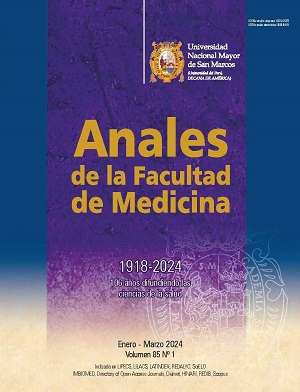Barriers and facilitators in the implementation of a tele-triage system for remote identification of suspected COVID-19 cases by student volunteers
DOI:
https://doi.org/10.15381/anales.v85i1.26016Keywords:
Triage, Telemedicine, Volunteers, COVID-19, PeruAbstract
Introduction. In Peru, the tele-triage system (TTS) led by volunteer students allowed for the remote identification of suspected COVID-19 cases. However, the barriers and facilitators of its implementation are still unknown. Objectives. To describe the barriers and facilitators regarding the implementation of a tele-triage system for the identification of suspected COVID-19 cases in Peru. Methods. A mixed-methods study was developed that described the characteristics of the users who participated in the TTS (quantitative). It also explored the perceptions of users and volunteers regarding the barriers and facilitators of implementing this service (qualitative). Results. Among the 4,317 users evaluated by the TTS, the average age was 36.2 years (standard deviation: 13.2), 58.6% were women, and only 41.4% were classified as suspected cases of COVID-19. Volunteers highlighted that their participation was facilitated by their availability of time and desire to help, although they noted problems with organization and a lack of equipment available for calls. Users valued the emotional support and clarity of the information provided but expressed mistrust about the remote COVID-19 assessment, and a limited understanding of the volunteers’ role. Conclusions. The TTS led by volunteer students allowed for the identification of suspected COVID-19 cases in Peru, and also served as a means to share information. However, aspects of disorganization and a lack of knowledge on the part of users were perceived as barriers to its implementation.
Downloads
Published
Issue
Section
License
Copyright (c) 2024 Anales de la Facultad de Medicina

This work is licensed under a Creative Commons Attribution-NonCommercial-ShareAlike 4.0 International License.
Those authors who have publications with this magazine accept the following terms:
- Authors will retain their copyrights and guarantee the journal the right of first publication of their work, which will be simultaneously subject to Creative Commons Attribution License that allows third parties to share the work as long as its author and its first publication this magazine are indicated.
- Authors may adopt other non-exclusive licensing agreements for the distribution of the version of the published work (eg, deposit it in an institutional electronic file or publish it in a monographic volume) provided that the initial publication in this magazine is indicated.
- Authors are allowed and recommended to disseminate their work over the Internet (eg: in institutional telematic archives or on their website) before and during the submission process, which It can produce interesting exchanges and increase quotes from the published work. (See El efecto del acceso abierto ).



